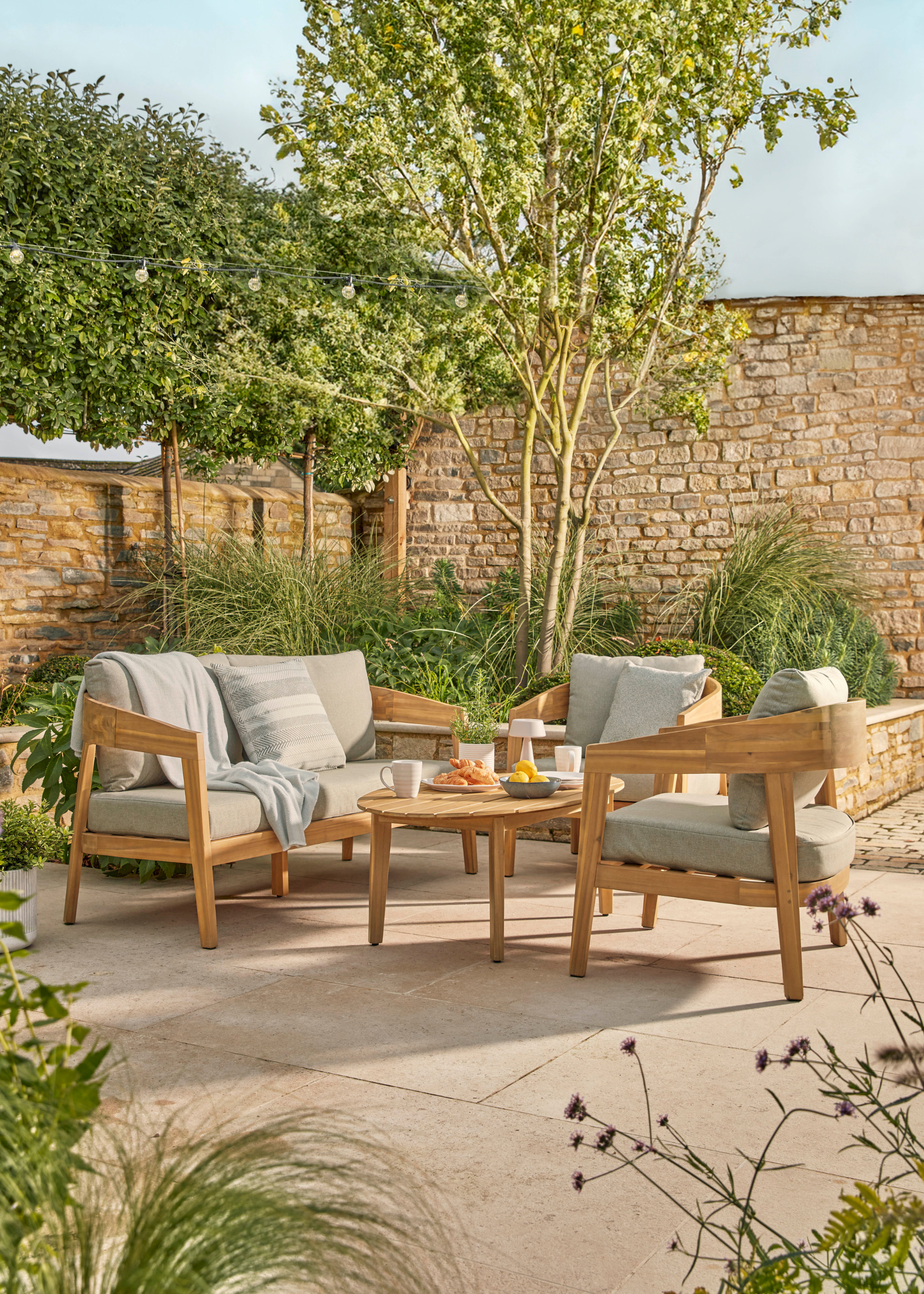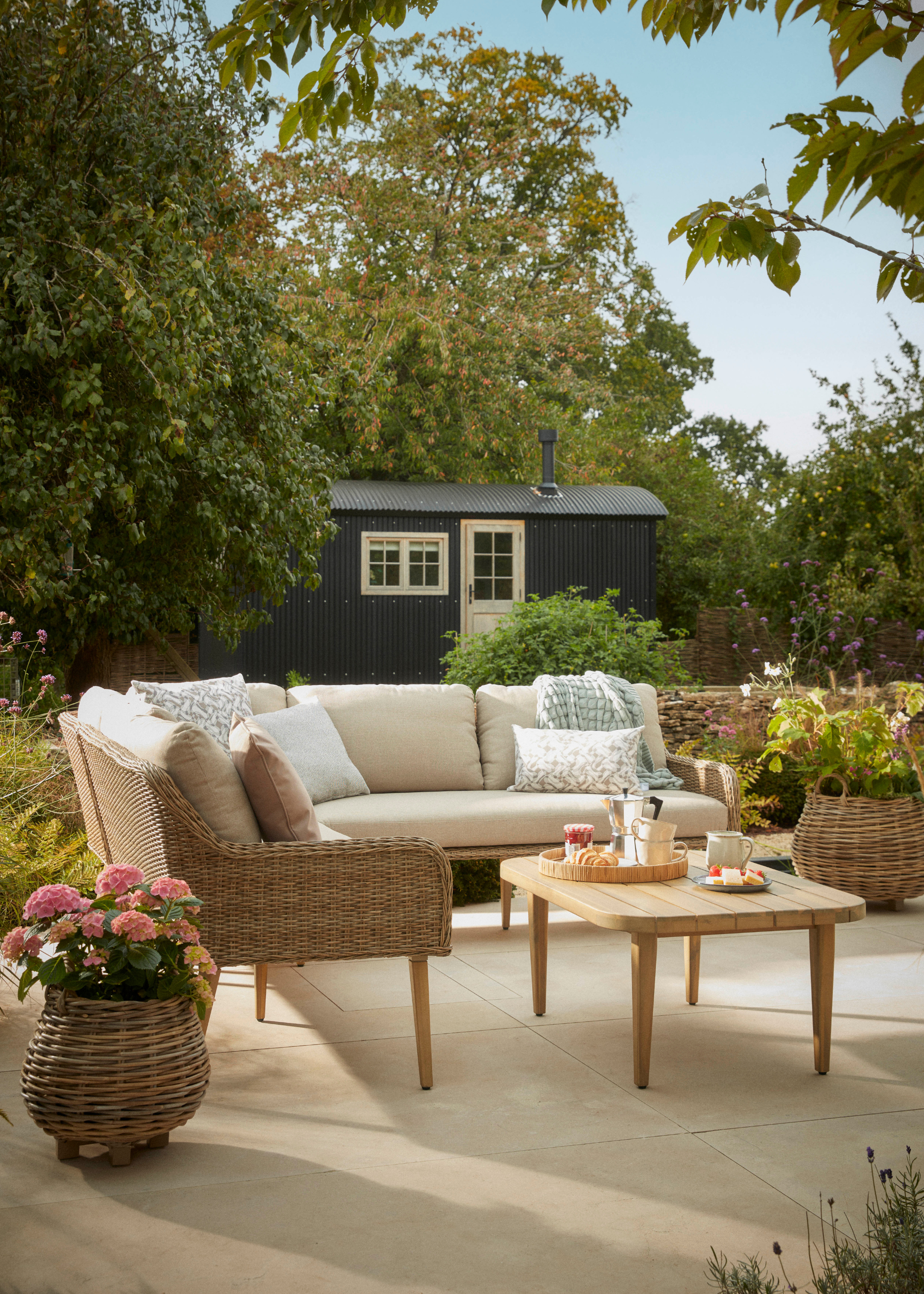
When it comes to different wood species, Acacia is, undeniably, one of the most popular options for outdoor furniture. But why has it earned this reputation, and is it deserved?
Well, according to the experts, yes, it is. At least... it is for the most part. This material is not completely free from its downfalls, as our experts will explain, so we can't say it's the very best wood for outdoor furniture but with some careful tricks and switches, it's more than capable of keeping your garden looking beautiful for years to come.
As interior designer Rachel Blindauer says, "In my years designing both interiors and outdoor environments for private residences and boutique hospitality, I’ve developed a respect for materials that hold their beauty through seasons of use. Acacia wood can be one of them—but only if you know how to work with its temperament."
And with uses dating back to Ancient Egypt, this material is more than worthy of your respect. Plus, with our expert's advice, you'll be able to make the absolute most of it, ensuring a garden with enduring beauty.
What is Acacia Wood?

This material finds its origins in Australia, where the Acacia tree is an indigenous plant. However, over the years, the Acacia has spread across the continents, with species found in countries across Africa, Australia, and Southeast Asia.
The acacia you'll most typically find being used for your furniture is known as Babul, a species native to Africa, the Middle East, and the Indian subcontinent. This particular breed is favored for its durability and hardwearing nature.
"It’s a naturally dense and durable hardwood, which makes it great for use in garden environments where it may be exposed to sun, wind, and rain, especially in UK weather conditions," explains Chloe Barrows, interiors expert at Laura James.
Acacia has a rich, distinctive look, with a natural luster that looks beautiful under direct sunlight. The material is typically of a warm, golden tone, with a surface texture littered with a striking graining pattern, making each piece unique.
While its beauty is certainly an appealing aspect to this fabric, its impressive durability is undoubtedly the driving force behind this wood's mass appeal. In fact, historically, acacia wood was the most popular material for the construction of boats, chosen for its impressive durability and water-resistance, so you can feel safe knowing this is one of the best woods for outdoor projects.
Why Is Acacia Good for Outdoors?

In short, yes, acacia wood is a perfectly suitable choice for outdoor use.
"Wooden furniture will always be a timeless choice, and acacia is a perfect hardwood for outdoor furniture, thanks to its lovely warm colour and attractive grain patterns," explains Danielle Le Vaillant, from Cox and Cox. However, she continues, "After a few years, most hardwoods will naturally age gracefully to a more silver-grey tone."
This change in surface color is an expected side-effect of constant sunlight exposure. High UV rays can break down the natural pigmentation of wooden materials, gradually developing a silver patina.
While acacia is still vulnerable to this kind of gradual wear, compared to other natural woods, this species stands out as an impressively durable option
"Unlike softer woods that can warp or discolour quickly, acacia has a natural resistance to wear and tear, so you get the warmth of real wood without compromising on longevity," comments Chloe.
Plus, coupled with a naturally appealing look, this material is understandably one of the most popular for wooden outdoor furniture.
"Acacia is technically suitable for outdoor use, and its rich grain and warm tone make it an attractive choice for clients who want wood with presence," says Rachel, "It’s dense, naturally water-resistant, and sustainably grown in many regions. But that doesn’t mean it’s carefree."
The Downfalls of Using Acacia Wood Outdoors

For all of Acacia's aesthetic and functional wins, there are still a few downfalls to consider before you go full wood-drenching and clad your whole garden in the material.
As Rachel explains, "The issue with acacia is not strength — it’s stability. Acacia tends to expand and contract with fluctuating moisture levels, which can lead to cracking or warping if the furniture is left exposed to rain and direct sun without protection. In other words, acacia doesn’t age effortlessly in the elements; it needs a little coddling."
This constant series of expansion and contraction can leave your wooden furniture looking worn out and aged, even if you've only had it for a few years. This will become a particularly prominent issue in more extreme climates, whereas in more consistent climates, it may not bother you as much.
"All wooden styles can expand and shrink under different weather conditions, which might lead to micro fractures in the wood, but this is perfectly natural and usually minimal," says Danielle.
Beyond these micro-fractures, the most notable issue with the material is its tendency to develop a patina, or face other changes in surface appearance. Though the legitimacy of this issue will ultimately come down to personal taste.
"The main risk isn’t the durability, but it’s more about maintaining the finish. It will naturally age over time and tends to develop a slight patina, however, many people love this as it can give the piece a more rustic look," explains Chloe.
However, if this 'rustic' look doesn't appeal, Chloe says, "If you want to preserve its brand-new golden-brown tone, you can always treat it with an outdoor wood oil, which will help to prevent this aging process. It’s also very low maintenance, as you’d only need to do this a maximum of once a year for the piece to stay in good condition for a long time."
Using a long-lasting sealant and regularly oiling your wood is the key to stopping your outdoor furniture from fading and creating an enduring beauty in your garden design.
The Best Alternative Materials for Outdoor Furniture

While acacia wood has certainly maintained a position as a firm favorite for outdoor furniture, this is not to say there aren't some strong contenders,
"In terms of other outdoor furniture materials, I also really like synthetic rattan with a sturdy frame," shares Chloe, "It’s incredibly low maintenance and ideal for those who want something they can just set up and enjoy without too much upkeep."
Or, for more industrial, urban garden ideas, Chloe says, "Concrete and terrazzo are also brilliant for more modern outdoor spaces, especially for side tables or statement pieces, but if you’re someone who wants the softness and character of real wood in their garden, acacia is one of the best value options out there."
Synthetic materials, like the rattan Chloe mentioned, have become an increasingly popular choice for those looking for low-maintenance outdoor furniture options.
As Danielle says, "While wooden garden furniture remains a firm favourite, advances in technology are making faux wicker an increasingly desirable choice. The subtle tonal variations now being created give our rattan sets that lovely, authentic visual appeal," she explains, "And of course the material has much higher levels of durability and UV resistance to keep it looking great for longer."
Although for those who desire the rustic look only offered by natural wood, the main debate will be around acacia vs teak.
For Rachel, there is one clear winner: "Teak is the gold standard. Naturally high in oils, it resists water and ages into a silvery patina without losing integrity," she says.
This is the kind of armchair the whole family will be fighting for their turn on. This Scandi, mid-century modern-inspired design oozes style while maintaining an invitingly comfortable look as well.
This gorgeous, soft seating dining set utilizes both acacia wood and rope for a laid-back luxury feel. Perfect for smaller gardens, without the space for a full dining setup.
These curved-back dining chairs have the kind of elegant design that can be hard to find in outdoor furniture. Pair them with a matching acacia dining table for an outdoor dining set that is as stylish as it is durable.
As Rachel puts it, "Acacia has the charm of an heirloom—but the maintenance demands of a thoroughbred."
So, as long as you're okay with a bit of maintenance and upkeep, this is the perfect material to bring to your outdoor setup. However, if you're looking for some more low-maintenance garden ideas, we love these recycled plastic outdoor furniture pieces, plus, they are sustainable.







